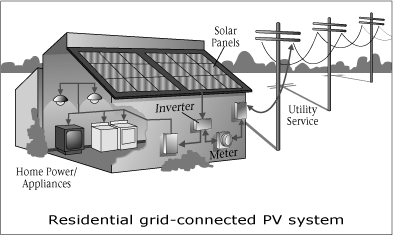|
Background
 |
What is a solar electric or photovoltaic system?
|
Photovoltaic (PV) systems convert sunlight directly to electricity. They
work any time the sun is shining, but more electricity is produced
when the sunlight is more intense and strikes the PV modules directly
(as when rays of sunlight are perpendicular to the PV modules). Unlike solar thermal systems for heating water, PV does not use the sun's heat to make electricity. Instead, electrons freed by the interaction of sunlight with semiconductor materials in PV cells are captured in an electric current.
PV allows you to produce electricity—without noise or air pollution—from a clean, renewable resource. A PV system never runs out of fuel, and it won't increase U.S. oil imports. Many PV system components are manufactured right here in the United States.
These characteristics could make PV technology the U.S. energy source of choice for the 21st century.
The basic building block of PV technology is the solar “cell.” Multiple PV cells are connected to form a PV “module,” the smallest PV component sold commercially. Modules range in power output from about 10 watts to 300 watts. A PV system connected or “tied” to the utility grid has these components:
- One or more PV modules, which are connected to an inverter
- The inverter, which converts the system's direct-current (DC) electricity to alternating current (AC)
- Batteries (optional) to provide energy storage or backup power in case of a power interruption or outage on the grid
AC electricity is compatible with the utility grid. It powers our lights, appliances, computers, and televisions. Special appliances that run directly on DC power are available, but they can be expensive.

Before you decide to buy a PV system, there are some things to consider:
First, PV produces power intermittently because it works only when the sun is shining. This is not a problem for PV systems connected to the utility grid, because any additional electricity required is automatically delivered to you by your utility. In the case of non-grid, or stand-alone, PV systems, batteries can be purchased to store energy for later use.
Second, if you live near existing power lines, PV-generated electricity is usually more expensive than conventional utility-supplied electricity. Although PV now costs less than 1% of what it did in the 1970s, the amortized price over the life of the system is still about 25 cents per kilowatt-hour. This is double to quadruple what most people pay for electricity from their utilities. A solar rebate program and net metering can help make PV more affordable, but they can't match today's price for utility electricity in most cases.
Finally, unlike the electricity you purchase monthly from a utility, PV power requires a high initial investment. This means that buying a PV system is like paying years of electric bills up front. Your monthly electric bills will go down, but the initial expense of PV may be significant. By financing your PV system, you can spread the cost over many years, and rebates can also lighten your financial load.
 |
Are incentives available to help reduce the cost?
|
Yes, many states offer incentives. For specific information, call one of the contacts listed under “Getting Help” at the end of this booklet. Another excellent source is the National Database of State Incentives for Renewable Energy (DSIRE). Prepared by the North Carolina Solar Center, this database contains information on financial and regulatory incentives that promote renewable energy technologies.
Net Metering—In more than 35 states, customers who own PV systems can benefit from laws and regulations that require “net” electric meter reading. The customer is billed for the net electricity purchased from the utility over the entire billing period—that is, the difference between the electricity coming from the power grid and the electricity generated by the PV system. Through net metering, the customer obtains the full retail electricity rate—rather than the much lower wholesale rate—for kilowatt-hours of PV- produced electricity sent to the utility power grid. The benefits of net metering to consumers are especially significant in areas such as Hawaii and New York, which have high retail electric rates. Utilities also benefit because the solar-generated energy often coincides with their periods of “peak” demand for electricity.
Property and Sales Tax—Tax incentives may include a sales tax exemption on the PV system purchase, a property tax exemption, or state personal income-tax credits, all of which provide an economic benefit to consumers by lowering high capital costs. The U.S. government also provides financial support for PV technology through a tax credit for commercial uses of solar energy. This energy investment credit provides businesses (but not individuals or utilities) with a 10% tax credit and 5-year accelerated depreciation for the cost of equipment used to generate solar electricity.
Buy-Down—Rebates and buydowns, typically based on the rated power of the system, help to defray high capital costs and to create competitive, sustainable market growth. In the United States, the U.S. Department of Energy has been involved in a program known as TEAM-UP, or Technology Experience to Accelerate Markets in Utility Photovoltaics. Through this program, some 80 utilities in 40 states have installed more than 7 megawatts of grid-connected PV; supplier buydowns and consumer rebates range between $2 and $4 per watt.
Residential Energy Rate—This is the average retail residential rate for energy from utilities, in cents per kilowatt-hour. Check your utility bill for your actual rate.
Source: National Renewable Energy Laboratory " A Consumer's Guide - Get Your Power From The Sun" June 2005
To download the guide in its entirety as a pdf document, please click on the first link above right.
|
|